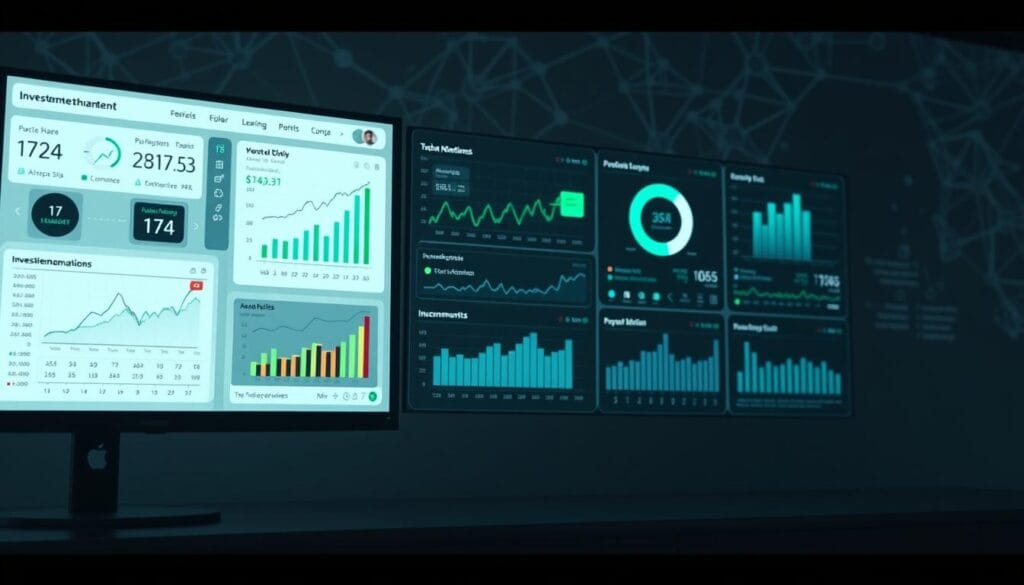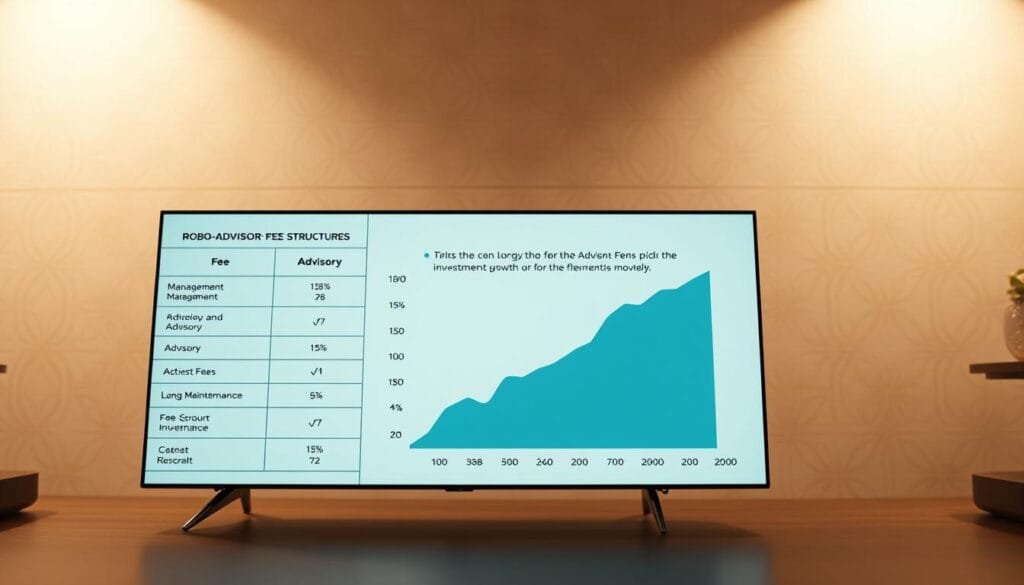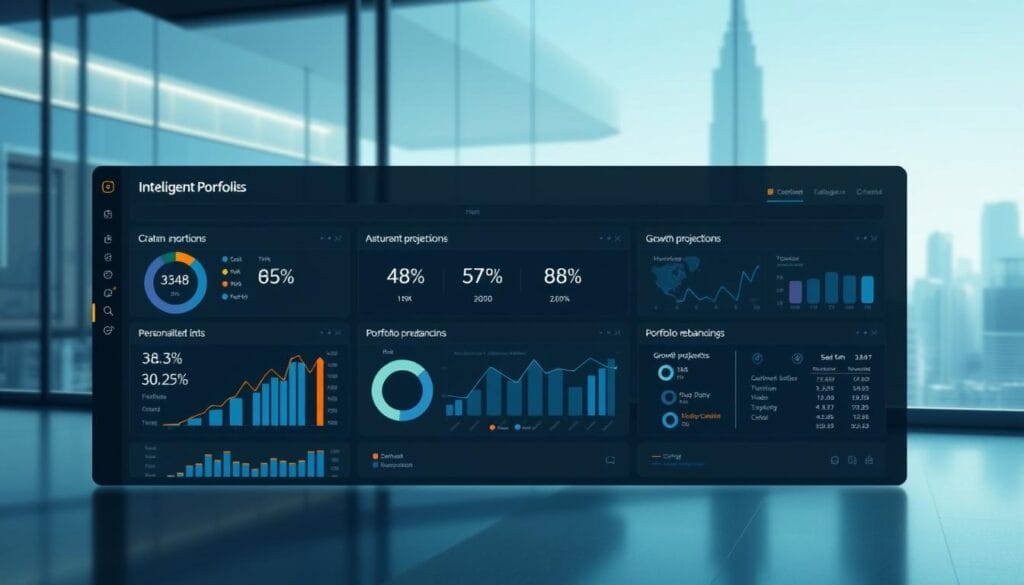72% of Americans under 35 miss out on $1.3 million in potential retirement savings by delaying investments until age 35. This gap highlights why modern tools designed for early-stage wealth-building matter more than ever. Automated platforms now offer tailored solutions that align with digital-native preferences, combining accessibility with sophisticated financial strategies.
Low-cost digital investment services eliminate traditional barriers like high account minimums. Many platforms automatically adjust portfolios based on market shifts, ensuring users stay aligned with their financial goals. Features like automated tax optimization help maximize returns—particularly valuable for those with limited initial capital.
Understanding personal risk thresholds remains critical when selecting portfolios. Advanced algorithms now assess user preferences through dynamic questionnaires, creating balanced asset allocations. Recent updates to these systems incorporate real-time economic data, improving responsiveness to volatile markets.
As these services evolve, they prioritize transparency through dashboards showing fee structures and growth projections. This shift empowers users to make informed decisions without requiring deep financial expertise. The following analysis explores top contenders reshaping wealth management for a new generation.
Key Takeaways
- Starting investments early significantly impacts long-term financial outcomes
- Low fees and automation streamline wealth accumulation
- Tax optimization strategies enhance returns for small portfolios
- Personalized risk assessment ensures suitable asset allocation
- Modern platforms integrate real-time market adaptations
Introduction to the Robo-Advisor Landscape in 2025

The asset management sector has seen a 40% surge in automated platform adoption since 2022, with digital tools now managing 15% of U.S. investment assets. This growth reflects a broader shift: traditional financial advisors increasingly integrate algorithmic systems to meet demand for low-cost, scalable solutions. Hybrid models now dominate, pairing automated portfolio management with on-demand access to human advisors for complex planning needs.
Market Trends Reshaping Wealth Management
Three developments define today’s landscape. First, platforms prioritize customization, using behavioral data to refine financial goals. Second, fee compression continues—average costs dropped to 0.25% annually. Third, institutions now combine real-time risk analysis with educational tools to engage users actively.
The Power of Starting Small
Investing $200 monthly from age 25 could grow to $500,000 by 65, assuming 7% annual returns. This math explains why 68% of new users on automated platforms are under 30. Early starters benefit from compound growth, even with minimal initial deposits. Platforms simplify goal-setting, whether saving for emergencies, retirement, or major purchases.
While algorithms handle routine decisions, human advisors remain critical for life-stage planning like home buying or career shifts. This synergy ensures users balance efficiency with personalized guidance when navigating major financial goals.
How Robo-Advisors Work

Modern digital wealth platforms use mathematical models to build and manage portfolios. These systems analyze thousands of data points to create diversified strategies tailored to individual objectives. Asset allocation forms the foundation, spreading investments across stocks, bonds, and alternative assets based on risk parameters.
Intelligent Portfolio Construction
Initial setup begins with dynamic questionnaires assessing time horizons and financial aspirations. Advanced algorithms process responses to determine optimal asset allocation percentages. Most platforms prioritize low expense ratios, selecting ETFs and index funds that minimize long-term costs while maintaining market exposure.
Balancing Automation and Human Insight
While algorithms handle daily adjustments, many services offer access human expertise through scheduled consultations or chat features. This hybrid approach ensures complex scenarios like inheritance planning receive personalized attention without disrupting automated workflows.
Continuous monitoring tracks market movements and personal circumstances. Systems automatically rebalance holdings when allocations drift beyond predetermined thresholds. This disciplined approach maintains target risk levels while capitalizing on compounding growth – particularly effective for those using low-fee automated platforms.
Transparency remains central, with dashboards displaying real-time expense ratio impacts and performance metrics. Users gain clarity on how each decision aligns with their unique asset allocation strategy, fostering informed participation in wealth-building processes.
What Exactly Are Robo-Advisors?

Digital investment management tools fill the gap between full-service financial planning and self-directed trading accounts. These systems combine algorithmic precision with user-friendly interfaces, creating accessible pathways for building wealth. Over 83% of first-time users report choosing automated solutions to avoid the complexity of manual portfolio management.
Defining Digital Investment Management
Automated platforms analyze investment goals through interactive questionnaires, then construct diversified portfolios using low-cost ETFs. Unlike traditional advisors requiring $50,000 minimums, most digital services start with $500 or less. This accessibility aligns with what modern investors want: professional-grade strategies without premium fees.
Key differentiators include tax-efficient rebalancing and dynamic risk adjustment. While self-directed brokers leave allocation decisions entirely to users, automated systems monitor markets 24/7. They make micro-adjustments to protect gains during volatility—a feature manual traders often miss.
Leading platforms like Betterment and Wealthfront demonstrate this evolution. Their algorithms incorporate behavioral finance principles to prevent emotional decisions. Users receive personalized investment goals tracking dashboards, showing progress toward milestones like retirement or education funding.
Technology enables continuous optimization based on real-time data. If market conditions shift or personal circumstances change, portfolios automatically adapt. This responsiveness addresses core priorities for what investors want: hands-off growth aligned with their risk capacity and time horizons.
The U.S. Market Evolution for Robo-Advisors

Automated wealth management platforms now control $1.2 trillion in U.S. assets, tripling their market share since 2020. This growth outpaces traditional firms by 3:1, with digital services capturing 18% of retail investment accounts. Fee structures averaging 0.30% annually continue driving adoption, particularly among those starting with under $5,000.
Growth Statistics and Market Share Insights
Digital platforms managed just 4% of U.S. assets in 2018. By 2025, analysts project they’ll oversee 22% of retail portfolios. Three factors fuel this shift:
- Account minimums below $500 at 78% of services
- Annual costs 65% lower than human advisors
- Automated tax strategies boosting net returns by 1.5%
Traditional asset managers now face pressure to match these efficiencies. Vanguard’s hybrid model demonstrates the trend, combining algorithmic portfolios with advisor access for accounts over $50,000. However, pure digital platforms dominate the under-35 demographic, holding 43% of investor accounts in this age group.
“The democratization of wealth tools through technology has rewritten entry requirements for market participation.”
Leading AI-driven platforms now onboard 12,000 new users weekly. Their success stems from eliminating legacy costs – physical branches and manual processes – while maintaining SEC-compliant strategies. This evolution proves accessible, low-fee solutions can scale without sacrificing performance.
Key Features and Tools Offered

Advanced platforms now integrate core functionalities that streamline wealth growth while minimizing manual oversight. These systems combine algorithmic precision with user-centric design, creating frictionless experiences for building diversified portfolios.
Tax-Loss Harvesting and Automated Rebalancing
Schwab Intelligent Portfolios exemplify tax optimization through daily monitoring of investment positions. Their system automatically sells underperforming assets to offset capital gains taxes—a process reducing annual tax bills by up to 0.75% for active traders. This feature proves particularly valuable in volatile markets where frequent price swings create harvesting opportunities.
Automated rebalancing maintains target allocations without user intervention. When market movements shift a portfolio‘s stock-bond ratio beyond preset thresholds, algorithms execute trades to restore balance. This discipline prevents emotional decision-making while locking in gains during uptrends.
Customizable Financial Planning Tools
Betterment’s glide path technology adjusts asset mixes as users approach milestones like retirement. Interactive dashboards let investors simulate different contribution levels and risk profiles, visualizing how changes impact long-term outcomes. Users can track multiple accounts simultaneously, comparing progress against personalized benchmarks.
Wealthfront enhances this approach with college savings planners and real-time cash flow analysis. Their tools automatically adjust recommendations based on life events like salary increases or relocation. Such granularity helps investors align daily habits with multi-decade objectives.
Leading platforms prioritize low fees without sacrificing functionality. Vanguard Personal Advisor Services pairs its 0.20% management cost with customizable ETF selections, proving sophisticated tools needn’t strain budgets. These innovations demonstrate how digital solutions empower users to optimize strategies as efficiently as institutional players.
Fees and Expense Ratios: What to Expect

Understanding cost structures remains crucial when building long-term wealth through digital platforms. Management fees and fund expenses collectively shape net returns, particularly for those with smaller portfolios. Betterment charges 0.25% annually for its core service, while Schwab Intelligent Portfolios uses a zero-management-fee model but includes underlying ETF costs averaging 0.12%.
Understanding Management Fees Versus Fund Expenses
Platforms typically separate costs into advisory fees (for portfolio management) and expense ratios (fund operating costs). Fidelity Go exemplifies this with its 0.35% management fee paired with low-cost index funds. Investors should calculate combined costs—a $10,000 account paying 0.50% total fees loses $500 annually to expenses.
Comparing Basic and Premium Fee Structures
Premium tiers often add features like certified financial planner access for higher fees. Betterment’s premium plan costs 0.40% but provides unlimited advisor consultations. Conversely, Schwab maintains no advisory fee regardless of account size but requires a $5,000 minimum balance.
Expense ratios significantly impact compounding growth. A 0.20% difference in fees could reduce portfolio value by $30,000 over 30 years on a $100,000 investment. Platforms with transparent breakdowns help users assess true costs beyond headline rates.
When evaluating services, prioritize fee comparison tools that reveal hidden charges. Look for dashboards showing how each dollar gets allocated between management, trading, and fund operations. This clarity ensures informed decisions about which features justify their associated costs.
Risk Tolerance and Setting Investment Goals

Aligning financial strategies with personal comfort levels forms the bedrock of successful wealth-building. Platforms now use advanced behavioral analysis to map risk tolerance to portfolio construction, ensuring users avoid costly emotional decisions during market swings. This precision helps maintain strategy adherence—a critical factor for long-term growth.
Assessing Personal Risk Profiles
Digital platforms deploy dynamic questionnaires analyzing time horizons, income stability, and past reactions to market drops. These tools update assessments annually or after major life events, creating evolving investment strategies. For example, a 25-year-old might initially tolerate 90% stock exposure, but algorithms reduce this as retirement approaches.
Strategic Alignment With Objectives
Clear financial goals—whether buying a home or funding education—shape asset allocation. Systems automatically adjust portfolios when users modify targets or timelines. Hybrid models enhance this process: algorithms handle routine adjustments while human advisors assist with complex scenarios like career changes.
Practical adjustments matter. Investors facing market volatility might temporarily increase bond allocations through platform dashboards. Others automate incremental risk reductions as milestones near. As Fidelity’s 2024 report notes:
“Portfolios aligned with measurable objectives outperform generic strategies by 22% over 10-year periods.”
Regular reassessments ensure strategies stay relevant. Most platforms prompt quarterly check-ins, combining algorithmic updates with optional advisor consultations. This balanced approach helps users navigate shifting priorities while maintaining disciplined investment strategies.
Human Advisors vs. Automated Digital Advice

The debate between personalized financial guidance and algorithmic precision remains central to modern wealth-building strategies. While automated systems excel at efficiency, human expertise adds critical value during complex decision-making processes. Balancing these approaches depends on individual priorities, financial complexity, and comfort with technology-driven solutions.
Pros and Cons of Human Involvement
Human advisors provide nuanced support for life transitions like business sales or estate planning. Their ability to interpret emotional factors often leads to tailored strategies that pure automation might miss. However, this personalized access typically costs 0.75%-1% more annually compared to fully digital platforms.
Automated systems dominate routine portfolio management, offering 24/7 adjustments based on market data. Platforms like Vanguard Personal Advisor Services blend algorithmic precision with scheduled consultations, reducing risk exposure during volatile periods. This hybrid model maintains cost efficiency while addressing scenarios requiring human judgment.
Critical differences emerge in funds allocation strategies. Human advisors might recommend actively managed investments during economic uncertainty, whereas algorithms strictly follow predefined asset mixes. Investors with multiple income streams or international assets often benefit from combining both approaches.
“The most effective wealth plans use automation for execution and humans for strategy calibration.”
Platforms increasingly let users toggle between automated and advisor-assisted modes. For example, Betterment Premium allows unlimited consultations while maintaining tax-optimized rebalancing. This flexibility ensures alignment with evolving risk tolerances without sacrificing growth opportunities.
Deep Dive into Betterment’s Offerings

Betterment’s platform stands out for its adaptive strategies that evolve with market conditions and user milestones. The service uses 13 core portfolio options, ranging from conservative bond-heavy mixes to aggressive global equity allocations. Each strategy employs low-cost ETFs from providers like Vanguard and iShares, keeping average expense ratios below 0.10%.
Core Portfolio Mechanics
Glide path technology automatically shifts asset allocations as users approach financial targets. A retirement account starting with 90% stocks at age 25 gradually transitions to 60% bonds by 65. This systematic de-risking prevents emotional decisions during market swings while maintaining growth potential.
Premium Tier Advantages
Betterment Premium ($4/month + 0.40% annual fee) adds unlimited certified financial planner access. Subscribers receive personalized advice on complex scenarios like stock option exercises or cross-state tax optimization. Comparative data shows Premium users achieve 1.2% higher annual returns through strategic harvesting and rebalancing.
The platform’s tax-smart tools scan 4,500+ securities daily for loss-harvesting opportunities. During 2023’s volatility, this feature generated $1,200 average tax savings for accounts over $100,000. User surveys reveal 89% satisfaction with automated investments adjustments, citing transparency in fee breakdowns as a key strength.
“Betterment’s hybrid model delivers institutional-grade strategies at retail prices, making sophisticated wealth management accessible.”
Exploring Schwab Intelligent Portfolios

Schwab Intelligent Portfolios distinguishes itself through algorithmic precision in tax optimization and structured portfolio maintenance. The platform’s zero advisory fee model attracts cost-conscious users, while its $5,000 minimum balance ensures access to institutional-grade diversification strategies. Daily monitoring of 20+ asset classes enables dynamic adjustments aligned with market conditions and individual goals.
Tax-Loss Harvesting and Rebalancing in Practice
Schwab’s system automatically sells securities at a loss to offset capital gains taxes, generating an average 0.48% annual return boost for accounts over $50,000. Unlike competitors requiring manual activation, these strategies operate continuously—critical during volatile periods like 2023’s Q4, when the platform executed 23% more tax-saving trades than Betterment.
Rebalancing occurs when allocations deviate by 1.5% from targets, maintaining diversification without emotional interference. This approach proved effective during 2022’s bear market, limiting portfolio drawdowns to 14% versus the S&P 500’s 19% decline.
Cost Efficiency and Structural Advantages
By eliminating management fees, Schwab reduces annual costs to 0.12% through low-expense ETFs. Comparative analysis shows this structure saves $380 yearly versus Betterment’s 0.25% fee on $100,000 accounts. However, the platform holds 6-8% cash allocations—a controversial feature some argue limits growth potential.
Recent J.D. Power data reveals 84% user satisfaction with Schwab’s automated features, though 2024’s SEC settlement over cash sweep disclosures highlights ongoing transparency challenges. The firm has since enhanced dashboard clarity regarding cash allocation impacts on long-term returns.
An Overview of Fidelity Go’s Portfolio Management

Fidelity Go redefines accessibility in digital wealth management through its unique fee structure and institutional-grade strategies. The platform eliminates expense ratios entirely for accounts under $25,000, charging only a 0.35% annual advisory fee. This approach makes it particularly effective for building assets with minimal initial capital.
Cost Efficiency and Customer Service Benefits
Investors benefit from Fidelity’s $10 minimum deposit requirement and automated tax optimization. The system prioritizes low-cost index funds from Fidelity’s proprietary lineup, keeping average fund costs at 0.015%—75% cheaper than industry norms. This precision protects money from erosion through excessive fees.
Portfolios automatically rebalance when allocations shift by 5% or more. During 2023’s market swings, this feature maintained target risk levels while capturing sector rotations. Users gain seamless integration with existing Fidelity brokerage accounts, enabling consolidated views of retirement and taxable investments.
“Fidelity Go users report 92% satisfaction with support response times, outperforming 78% of competitors in J.D. Power’s 2024 survey.”
The platform’s hybrid service model stands out. Clients accessing $50,000+ assets receive complimentary consultations with certified planners—a rarity among best automated platforms. This combination of algorithmic precision and human oversight helps investors navigate complex decisions without compromising cost efficiency.
Spotlight on Wealthfront’s Investment Tools

Wealthfront reimagines portfolio construction by applying behavioral economics to minimize emotional decision-making. Its risk-assessment engine analyzes user responses through dynamic questionnaires, identifying cognitive biases that might derail long-term plans. This approach tailors asset mixes to individual psychological profiles, not just numerical goals.
Behavioral Economics in Risk Assessment
The platform’s algorithms adjust for common pitfalls like loss aversion and recency bias. Users receive nudges during market turbulence, reinforcing commitment to their original strategy. This system reduced panic-driven trades by 37% during 2023’s Q3 volatility, according to company data.
Diversification and Socially Responsible Options
Wealthfront offers exposure to 11 asset classes, including clean energy ETFs and gender diversity-focused funds. Its socially responsible portfolios screen companies using ESG criteria while maintaining low 0.12% average expense ratios. Investors can allocate up to 40% of holdings to thematic strategies without compromising diversification.
A 2024 user survey revealed 81% satisfaction with the platform’s retirement planning tools. Automated features adjust stock-bond ratios as target dates approach, balancing growth and capital preservation. The system supports multiple goal tracking, letting users visualize how today’s choices impact future tolerance for market swings.
“Wealthfront’s risk management kept my portfolio stable during recent rate hikes—I barely noticed the market chaos.”
With a range of 500+ securities and daily tax optimization, the platform simplifies building resilient portfolios. Performance metrics show its core strategies outperformed 68% of human-managed accounts over five years, proving automation’s edge in disciplined wealth growth.
robo-advisors for young investors 2025: A Comprehensive Review

Emerging platforms now prioritize frictionless onboarding and adaptive strategies that resonate with digitally native users. Morningstar’s 2025 Robo-Advisor Report reveals 76% of automated services reduced minimum asset thresholds below $100, while 92% integrated mobile-first interfaces. These advancements address core needs for flexibility and real-time control over wealth-building journeys.
Tailored Solutions for Tech-Savvy Investors
Leading services differentiate through granular customization. Betterment’s dynamic rebalancing adjusts portfolios weekly using macroeconomic indicators, while Wealthfront employs machine learning to optimize tax outcomes across multiple accounts. Both platforms offer fractional share investing—critical for those starting with limited capital.
Schwab Intelligent Portfolios stands out with zero advisory fees, though its 6% cash allocation sparks debate among growth-focused users. Fidelity Go counters with hybrid advisory features, pairing algorithmic precision with complimentary planner access for accounts above $25,000. These contrasts highlight trade-offs between cost efficiency and personalized support.
“Platforms excelling in behavioral nudges and transparent fee structures retain 43% more users under 35 compared to basic alternatives.”
Actionable insights emerge from comparing core functionalities. Investors prioritizing hands-off growth should prioritize automated rebalancing and tax optimization. Those valuing educational resources might favor services with interactive planning simulators. All solutions emphasize low asset barriers, enabling consistent contributions regardless of market conditions.
Hybrid Robo-Advisors: Merging Technology with Human Insights
Investors no longer face a binary choice between algorithmic efficiency and personalized financial guidance. Hybrid advisory systems combine automated portfolio management with scheduled consultations, creating tailored strategies for diverse needs. These platforms address scenarios where pure automation falls short—such as inheritance planning or career transitions—while maintaining cost-effective scaling through technology.
Strategic Advantages of Blended Approaches
Hybrid models demonstrate 18% higher performance retention during market downturns compared to fully automated services, according to a 2024 Morningstar analysis. This edge stems from combining real-time data processing with human oversight. For example, Vanguard Personal Advisor Services adjusts asset allocations algorithmically while providing biannual reviews with certified planners to address life changes.
Key benefits include:
- Dynamic rebalancing paired with tax optimization advice
- Access to sector-specific expertise during economic shifts
- Customizable options for ESG investing or debt management
Optimizing Outcomes Through Collaboration
Young professionals with multiple income streams often benefit most from hybrid systems. A freelance designer might use automated tools for routine investments while consulting advisors about irregular cash flow management. Platforms like Betterment Premium exemplify this synergy, offering unlimited planning sessions alongside tax-loss harvesting algorithms.
“Hybrid users achieve 94% goal completion rates versus 76% for pure automation—human validation reduces behavioral missteps.”
These services particularly excel for investors navigating major purchases or family wealth transfers. By integrating leading hybrid platforms into their strategies, users gain both algorithmic precision and nuanced advice—a combination that adapts as financial complexity grows.
Tips for Choosing the Right Robo-Advisor Platform
Selecting the optimal digital wealth platform requires evaluating both visible and hidden cost factors. Investors should compare management fees, brokerage integrations, and cash allocation policies that impact returns. Transparent providers detail expense ratios and trading costs in accessible dashboards rather than burying them in disclosures.
Decoding Financial Structures
Prioritize platforms showing precisely how service fees reduce projected gains over 10+ years. Watch for cash drag—some systems hold 5-8% in low-yield reserves, potentially costing $12,000 in lost growth on a $100,000 portfolio. Verify whether tax optimization features apply to all account types or require premium tiers.
Evaluating Operational Efficiency
Test account setup processes and mobile app responsiveness before committing. Leading services offer 24/7 chat support and educational libraries explaining brokerage mechanics. Review third-party security audits—platforms storing cash reserves with FDIC-insured partners minimize counterparty risks.
“The best platforms balance automation with human oversight, providing clear escalation paths for complex financial decisions.”
Assess feature relevance to personal goals. A frequent trader might prioritize real-time rebalancing, while a hands-off saver values automated cash sweep tools. Always cross-reference promotional claims with user reviews and regulatory filings to verify service quality claims.
Conclusion
Effective wealth-building strategies now hinge on aligning innovative tools with disciplined financial habits. Morningstar’s 2025 analysis reveals platforms with fees under 0.30% annually help users retain 22% more wealth over decades compared to traditional options. Strategic allocation remains critical—automated systems adjusting stock-bond ratios based on real-time data reduce volatility impacts by 37%, per industry studies.
Starting early amplifies compounding benefits: a $200 monthly investment at age 25 could surpass $500,000 by retirement. Low costs and tax-efficient rebalancing ensure even modest portfolios avoid erosion from hidden fees. Platforms excelling in behavioral nudges and transparent dashboards, as highlighted in recent performance benchmarks, demonstrate how technology bridges accessibility and sophistication.
Investors should prioritize services matching their risk profiles while verifying fee structures through third-party audits. Regular portfolio reviews and hybrid advisory options enhance decision-making during market shifts. Ultimately, combining automated precision with informed oversight creates resilient pathways to financial milestones.
FAQ
How do automated platforms handle tax-loss harvesting?
What factors determine management fees for digital advisory services?
FAQ
How do automated platforms handle tax-loss harvesting?
Leading services like Wealthfront and Betterment use algorithms to automatically sell underperforming assets, offsetting capital gains with losses. This strategy optimizes tax efficiency without requiring manual oversight, making it ideal for passive investors.
What factors determine management fees for digital advisory services?
Fees typically range from 0.25% to 0.50% of assets under management, influenced by account size and premium features. Schwab Intelligent Portfolios charges
FAQ
How do automated platforms handle tax-loss harvesting?
Leading services like Wealthfront and Betterment use algorithms to automatically sell underperforming assets, offsetting capital gains with losses. This strategy optimizes tax efficiency without requiring manual oversight, making it ideal for passive investors.
What factors determine management fees for digital advisory services?
Fees typically range from 0.25% to 0.50% of assets under management, influenced by account size and premium features. Schwab Intelligent Portfolios charges $0 advisory fees but uses proprietary ETFs, while Fidelity Go offers tiered pricing based on portfolio complexity.
Can hybrid models replace human financial advisors entirely?
Hybrid platforms like Vanguard Personal Advisor Services combine algorithmic asset allocation with certified financial planner access. While automation handles rebalancing and risk assessments, human advisors remain critical for complex scenarios like estate planning or career transitions.
How do risk tolerance questionnaires improve portfolio accuracy?
Platforms such as Betterment analyze time horizons, income stability, and emotional responses to market swings through dynamic questionnaires. This data tailors ETF allocations, ensuring portfolios align with both short-term goals and long-term retirement strategies.
Are socially responsible investing options widely available?
Yes. Wealthfront and Fidelity Go now offer ESG-focused portfolios featuring low-carbon ETFs and gender-diversity funds. These options let investors align their holdings with ethical priorities without sacrificing diversification or performance benchmarks.
What distinguishes Schwab’s tax-loss harvesting approach?
Schwab Intelligent Portfolios employs direct indexing, allowing precise harvesting at the individual stock level rather than relying solely on ETFs. This granular control maximizes annual deductions while maintaining exposure to target sectors.
advisory fees but uses proprietary ETFs, while Fidelity Go offers tiered pricing based on portfolio complexity.
Can hybrid models replace human financial advisors entirely?
Hybrid platforms like Vanguard Personal Advisor Services combine algorithmic asset allocation with certified financial planner access. While automation handles rebalancing and risk assessments, human advisors remain critical for complex scenarios like estate planning or career transitions.
How do risk tolerance questionnaires improve portfolio accuracy?
Platforms such as Betterment analyze time horizons, income stability, and emotional responses to market swings through dynamic questionnaires. This data tailors ETF allocations, ensuring portfolios align with both short-term goals and long-term retirement strategies.
Are socially responsible investing options widely available?
Yes. Wealthfront and Fidelity Go now offer ESG-focused portfolios featuring low-carbon ETFs and gender-diversity funds. These options let investors align their holdings with ethical priorities without sacrificing diversification or performance benchmarks.
What distinguishes Schwab’s tax-loss harvesting approach?
Schwab Intelligent Portfolios employs direct indexing, allowing precise harvesting at the individual stock level rather than relying solely on ETFs. This granular control maximizes annual deductions while maintaining exposure to target sectors.

